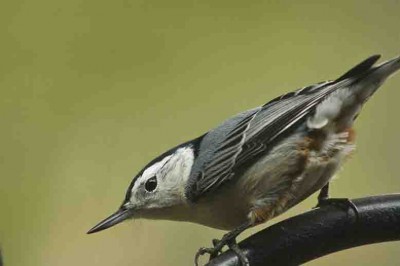Before coming to Shaver’s Creek, I could identify a few birds, and occasionally noticed them coming to the feeders at my parents’ house. They livened the woods in spring, and endured the cold in winter, and once in 6th grade I wrote a paper imagining the thrill of flying with the powerful wings of a Red-tailed Hawk. But my few encounters with birds would not amount to birdwatching in anyone’s mind; it was simply an awareness. Coming here as an intern in the fall, I was struck by the interest in and dedication to not only teaching, but also learning; everyone at the Center seemed to be eager to expand their own knowledge and participate in the learning process. The energy surrounding teaching and learning about the world of birds was especially intriguing to me, and I was soon hooked, on my way to becoming a “bird nerd.” Through Migration Morning Bird Walks, visits to the Hawk Watch at Stone Mountain, and my own amateur birding endeavors, I practiced and learned and enjoyed. As the last fall warblers passed through, and the days became shorter, another birding opportunity arose, one that I have been able to enjoy throughout these snowy winter days: watching birds at the feeder.
Dubbed the Project FeederWatch Fanatic, it has been my responsibility over the course of the winter months to keep the feeders at our feeding station filled and functional, as well as record the winter visitors to our feeders and report the findings to the Cornell Lab of Ornithology’s Project FeederWatch. The routine of filling the feeders each morning, observing the feeders throughout the week, and entering data online has become very dear to me and has kept me engaged and learning.
Even on the bitterest cold days, I keep at the feeders for the pure delight of chickadee wings rushing past as the hardy winter resident lands on the sunflower feeder a foot away. Then, with a fire blazing in the woodstove and a mug of coffee in hand, I sit at the big picture window in the Lower Classroom and watch the birds enjoy the seed, suet, and peanut butter provided. Observing them flit to and from the feeders day after day, I learn the habits of each species, and each becomes more remarkable the closer I look. Most of the time, the feeders are teeming with “typical” birds: Black-capped Chickadees, Tufted Titmice, Dark-eyed Juncos, Nuthatches. But the Tufted Titmouse doesn’t seem so ordinary when I observe its careful feeding habit: selecting the finest black oil sunflower seed and bringing it to a nearby perch, where it holds the seed between its feet and pecks out the nutritious kernel. And I come to appreciate the drab olive of winter Goldfinches as much as their ubiquitous yellow summer plumage as they crowd every last perch on the thistle feeder. An early morning observer might see a brilliant red Northern Cardinal creep shyly out of the yew bush that provides shelter for the birds as they make a dash for the feeders. I caught my breath the first time I saw a Carolina Wren clinging to the peanut butter feeder, matching the delicate chestnut bird to its blithe song of early winter. Once, I saw an American Tree Sparrow chase off the larger White-throated Sparrow from its patch of fallen seeds on the ground, and I’ve learned how to tell the subtle difference between the streaked Song Sparrow and the White-throated. The excitement surrounding the bird feeders is contagious as well. News that a Red-breasted Nuthatch was frequenting our feeders traveled around the center like a rumor in middle school, and staff meeting was once interrupted to point out a Hairy Woodpecker.
Observing and learning about the feeder birds, sharing the experience with my coworkers and visitors to the center, and participating in a national citizen science project (Project FeederWatch) has kept me busy and energized throughout the cold, grey winter. I feel a connection to the birds, and an interest in their ecology and habitat. I believe that by forming an emotional connection to the environment, whether that connection is made through birding or rock climbing or gardening or fort building, we come to care for the environment, and we want to learn about it and protect it. Countless students, visitors, and staff members have become hooked on birding over the years sitting at the picture window watching the birds at our feeding station, just as I have done. This connection to the birds at the feeder has surely helped to develop an environmental consciousness among these “bird nerds,” and the impact of this consciousness, sparked by the simple act of watching feeder birds, is unknown.
Many people wonder if it’s necessary to feed birds in the winter time; do they need our handouts to survive the winter? The answer is no. These astounding wild creatures are perfectly equipped to make it to spring, and their adaptations to do so are remarkable. And so, perhaps the question instead ought to be if we can make it through the long winter without the pleasure and inspiration of their company at our feeders.
With photos by Kaitlin Pope and Justin Raymond.





